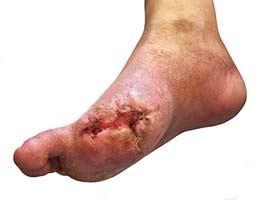
An ulcer is an open wound in the skin that will not heal. Ulcers usually begin as an area of redness on the skin. The area may have a different firmness or temperature than the surrounding skin, or may be painful to the touch (Stage I), similar to a blister. Over time, the skin will break down, exposing a shallow wound bed (Stage II), followed by a layer of fat beneath the skin (Stage III), until bones, tendons, or muscles are exposed (Stage IV). Alternatively, the ulcer may be covered with discolored tissue (ranging from yellow to green to brown or black), making it impossible to determine the extent of the damage simply by looking at the ulcer.i
What Causes Non-Healing Foot Ulcers?

Non-Healing foot ulcers usually begin as an area of redness on the skin, which eventually breaks down over time, resulting in an open wound in the skin that will not heal. Ulcers may be caused by underlying medical conditions or personal habits.
5 Common Causes of Non-Healing Foot Ulcers
1. Circulatory Problems
Your circulatory system carries oxygen-rich blood and nutrients to your entire body. These nutrients maintain healthy tissue. The feet are frequently first to show signs of trouble when circulation is impaired, which is why they should be inspected regularly. ii Even if there is no sign of an ulcer upon examination, if there are any irregularities, such as pain, numbness, hair loss, or discoloration on the legs or feet, it could be indicative of a condition called peripheral artery disease (PAD). PAD can lead to severe pain, ulcers, amputation and even death if left untreated. Find out if you are at risk for PAD, and contact a PAD specialist to avoid ulcers and other complications of a compromised circulatory system.
2. Nerve Damage
Nerve damage can occur in patients with circulatory problems, diabetes, alcoholism, or atherosclerosis (the hardening of arteries). When nerves are intact, they send signals to the brain when an object is causing pain or discomfort. For instance, when sitting in one position for a long time, a sensation of discomfort will cause a person to shift his or her body, or stretch his or her legs. When walking, a feeling of pain will cause a person to remove a foreign object from their shoe, or seek out better-fitting footwear. iii However, in cases of damaged nerves, they are no longer able to properly signal the brain if an object or body position is causing harm to the tissue. This failure to signal the brain can result in a person staying in one position for prolonged periods of time, or not fixing an issue with footwear. The pressure and irritation can then, over time, develop into an ulcer.iv
3. Prolonged Pressure On the Feet
As mentioned in the previous example, when shoes fit poorly, ulcers can occur. In people without nerve damage, this is usually due to severe atherosclerosis, or a deformity such as a fracture. Elderly patients often have difficulty or find it uncomfortable to examine their feet, ignoring moderate pain from pressure on the feet, which may result in the development of an ulcer.v
4. Conditions Such As Peripheral Artery Disease, Kidney Failure, Diabetes, High Cholesterol, Or High Blood Pressure
Ulcers are an indication that a severe stage of a condition such as peripheral artery disease, kidney failure, diabetes, high cholesterol, or high blood pressure is present. This is because these conditions impair circulation and damage nerves, increasing the risk for developing ulcers. A primary care physician or PAD specialist can offer strategies on managing these conditions — medication, healthy diet, exercise, and proper weight management can often significantly decrease the risk for ulcers.vi
5. Lifestyle Factors Such As Smoking Or Sedentary Lifestyle
Smoking increases the risk for multiple diseases, including peripheral artery disease, due to its restrictive effects on the circulation.
Ulcers occur when there is consistent pressure on one area for long periods of time. Prolonged periods of bed rest, or a sedentary lifestyle, can cause this type of pressure, and encourage the formation of ulcers.vii
At any stage, an open wound can become infected and emit a bad odor and pus. When left untreated, ulcers can lead to severe complications such as gangrene and amputation. Frequent examination of your feet is recommended to help detect the presence of an ulcer in its earliest stages.
If you discover a wound that will not heal on your feet, or on a loved one’s feet, contact your primary care physician immediately. If blood vessels are blocked, a PAD specialist should be consulted to determine the best course of treatment to restore blood flow to the damaged area. Foot ulcer treatment options are less invasive when detected in the early stages. Without immediate attention to restore oxygen-rich blood delivery to the ulcerated area, healing will not occur. Untreated foot ulcers carry a significant risk for amputation
Sources:
i http://www.ncbi.nlm.nih.gov.proxy.lib.mcw.edu/pubmed/24149664
ii http://www.ncbi.nlm.nih.gov/pmc/articles/PMC2494620/
iii http://www.everydayhealth.com/foot-health/get-the-facts-on-foot-ulcers.aspx
iv http://www.drugs.com/health-guide/foot-ulcers.html
v http://www.ncbi.nlm.nih.gov/pmc/articles/PMC2494620/
vi http://my.clevelandclinic.org/services/heart/disorders/pad/legfootulcer
vii http://www.ncbi.nlm.nih.gov/pubmed/17824939


